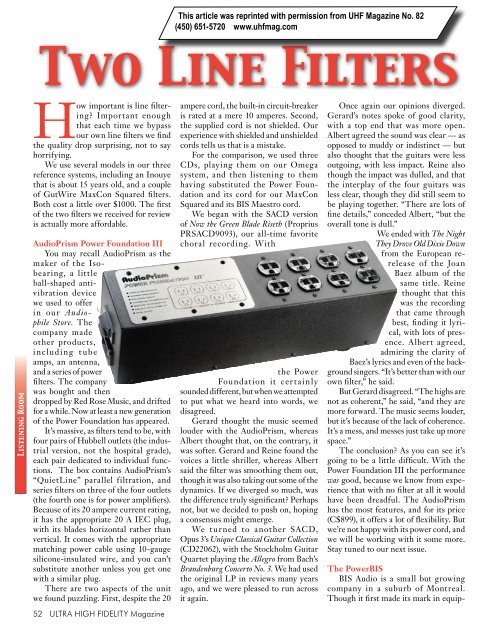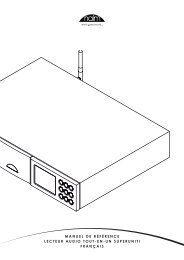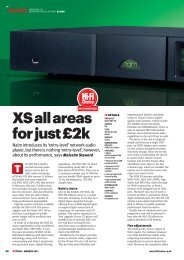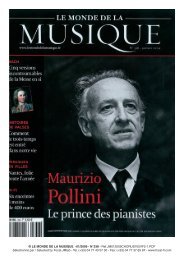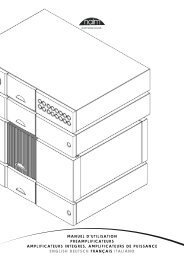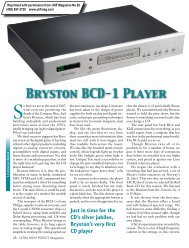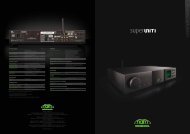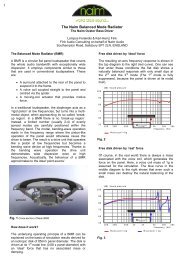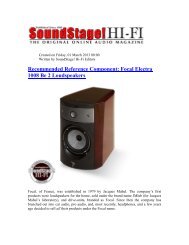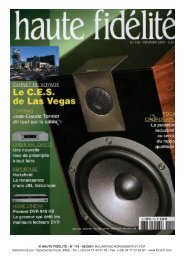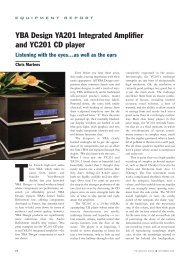December 2007 - Bis Audio
December 2007 - Bis Audio
December 2007 - Bis Audio
Create successful ePaper yourself
Turn your PDF publications into a flip-book with our unique Google optimized e-Paper software.
Listening Feedback Room<br />
This article was reprinted with permission from UHF Magazine No. 82<br />
(450) 651-5720 www.uhfmag.com<br />
Two Line Filters<br />
How important is line filtering<br />
Important enough<br />
that each time we bypass<br />
our own line filters we find<br />
the quality drop surprising, not to say<br />
horrifying.<br />
We use several models in our three<br />
reference systems, including an Inouye<br />
that is about 15 years old, and a couple<br />
of GutWire MaxCon Squared filters.<br />
Both cost a little over $1000. The first<br />
of the two filters we received for review<br />
is actually more affordable.<br />
<strong>Audio</strong>Prism Power Foundation III<br />
You may recall <strong>Audio</strong>Prism as the<br />
maker of the Isobearing,<br />
a little<br />
ball-shaped antivibration<br />
device<br />
we used to offer<br />
in our <strong>Audio</strong>phile<br />
Store. The<br />
company made<br />
other products,<br />
i nclud i ng t ube<br />
amps, an antenna,<br />
and a series of power<br />
filters. The company<br />
was bought and then<br />
dropped by Red Rose Music, and drifted<br />
for a while. Now at least a new generation<br />
of the Power Foundation has appeared.<br />
It’s massive, as filters tend to be, with<br />
four pairs of Hubbell outlets (the industrial<br />
version, not the hospital grade),<br />
each pair dedicated to individual functions.<br />
The box contains <strong>Audio</strong>Prism’s<br />
“QuietLine” parallel filtration, and<br />
series filters on three of the four outlets<br />
(the fourth one is for power amplifiers).<br />
Because of its 20 ampere current rating,<br />
it has the appropriate 20 A IEC plug,<br />
with its blades horizontal rather than<br />
vertical. It comes with the appropriate<br />
matching power cable using 10-gauge<br />
silicone-insulated wire, and you can’t<br />
substitute another unless you get one<br />
with a similar plug.<br />
There are two aspects of the unit<br />
we found puzzling. First, despite the 20<br />
ampere cord, the built-in circuit-breaker<br />
is rated at a mere 10 amperes. Second,<br />
the supplied cord is not shielded. Our<br />
experience with shielded and unshielded<br />
cords tells us that is a mistake.<br />
For the comparison, we used three<br />
CDs, playing them on our Omega<br />
system, and then listening to them<br />
having substituted the Power Foundation<br />
and its cord for our MaxCon<br />
Squared and its BIS Maestro cord.<br />
We began with the SACD version<br />
of Now the Green Blade Riseth (Proprius<br />
PRSACD9093), our all-time favorite<br />
choral recording. With<br />
the Power<br />
Foundat ion it certainly<br />
sounded different, but when we attempted<br />
to put what we heard into words, we<br />
disagreed.<br />
Gerard thought the music seemed<br />
louder with the <strong>Audio</strong>Prism, whereas<br />
Albert thought that, on the contrary, it<br />
was softer. Gerard and Reine found the<br />
voices a little shriller, whereas Albert<br />
said the filter was smoothing them out,<br />
though it was also taking out some of the<br />
dynamics. If we diverged so much, was<br />
the difference truly significant Perhaps<br />
not, but we decided to push on, hoping<br />
a consensus might emerge.<br />
We turned to another SACD,<br />
Opus 3’s Unique Classical Guitar Collection<br />
(CD22062), with the Stockholm Guitar<br />
Quartet playing the Allegro from Bach’s<br />
Brandenburg Concerto No. 3. We had used<br />
the original LP in reviews many years<br />
ago, and we were pleased to run across<br />
it again.<br />
Once again our opinions diverged.<br />
Gerard’s notes spoke of good clarity,<br />
with a top end that was more open.<br />
Albert agreed the sound was clear — as<br />
opposed to muddy or indistinct — but<br />
also thought that the guitars were less<br />
outgoing, with less impact. Reine also<br />
though the impact was dulled, and that<br />
the interplay of the four guitars was<br />
less clear, though they did still seem to<br />
be playing together. “There are lots of<br />
fine details,” conceded Albert, “but the<br />
overall tone is dull.”<br />
We ended with The Night<br />
They Drove Old Dixie Down<br />
from the European rerelease<br />
of the Joan<br />
Baez album of the<br />
same title. Reine<br />
thought that this<br />
was the recording<br />
that came through<br />
best, finding it lyrical,<br />
with lots of presence.<br />
Albert agreed,<br />
admiring the clarity of<br />
Baez’s lyrics and even of the background<br />
singers. “It’s better than with our<br />
own filter,” he said.<br />
But Gerard disagreed. “The highs are<br />
not as coherent,” he said, “and they are<br />
more forward. The music seems louder,<br />
but it’s because of the lack of coherence.<br />
It’s a mess, and messes just take up more<br />
space.”<br />
The conclusion As you can see it’s<br />
going to be a little difficult. With the<br />
Power Foundation III the performance<br />
was good, because we know from experience<br />
that with no filter at all it would<br />
have been dreadful. The <strong>Audio</strong>Prism<br />
has the most features, and for its price<br />
(C$899), it offers a lot of flexibility. But<br />
we’re not happy with its power cord, and<br />
we will be working with it some more.<br />
Stay tuned to our next issue.<br />
The PowerBIS<br />
BIS <strong>Audio</strong> is a small but growing<br />
company in a suburb of Montreal.<br />
Though it first made its mark in equip-<br />
52 ULTRA HIGH FIDELITY Magazine
Listening Feedback Room<br />
ment modifications, like a lot of high end<br />
companies, it is now specialized in cables.<br />
We have included BIS products in other<br />
reviews. The company did well in a test<br />
of interconnect cables, and spectacularly<br />
well in a comparison of power cables. Its<br />
top-of-the-line Maestro cable now connects<br />
our MaxCon Square<br />
filter to the wall.<br />
The PowerBIS<br />
is at once a power<br />
bar and a line<br />
filter. It seems<br />
feather-light in<br />
comparison with<br />
the others, but the<br />
fit and finish are first<br />
rate. The six outlets are from Hubbell,<br />
and the IEC connector an audio-grade<br />
unit from Furutech. The filtering is<br />
entirely of the parallel sort. Rather than<br />
blocking the passage of undesirable noise<br />
(and, inevitably, some current as well), it<br />
attempts to short it out. That is clearly<br />
friendlier to large power amplifiers.<br />
The list price is surprisingly low for<br />
a filter, just C$450 (we’re not supplying<br />
a US dollar equivalent, because the<br />
two currencies are virtually at par). A<br />
slightly more expensive version, at $495,<br />
has eight outlets instead of six. Both<br />
versions are optionally available with<br />
the IEC connector on top rather than<br />
at the end. If the unit will be placed on<br />
the floor behind an equipment rack,<br />
that is likely to be the more convenient<br />
configuration.<br />
However like the MaxCon and unlike<br />
the <strong>Audio</strong>Prism, the PowerBIS<br />
doesn’t come with a<br />
power cord. Since the<br />
IEC connector is standard you<br />
can of course choose the cable you like.<br />
BIS sent us what it considers a matching<br />
cable, the AC 20 WG, which, at $700,<br />
costs far more than the PowerBIS itself.<br />
Initially we used them together.<br />
We moved our gear over to the<br />
PowerBIS and listened again to Now the<br />
Green Blade Riseth. It certainly sounded<br />
very good, with excellent articulation<br />
by the singers, and strong rhythm. Both<br />
Reine and Albert judged the performance<br />
equal to that of our own filter.<br />
“You can see the music,” said Albert.<br />
Gerard thought the bottom end<br />
might be a little lighter, and the top not<br />
quite as smooth, but none of us thought<br />
the differences were major. Score one for<br />
the PowerBIS.<br />
With the second recording, that<br />
of Bach transcribed for four guitars,<br />
our doubts evaporated. The sound was<br />
magnificent, the music filled with joy<br />
and life. The image was well defined,<br />
and we could easily distinguish the four<br />
instruments (which, we recalled, sometimes<br />
ran together even in the days when<br />
we listened to them on vinyl). Albert<br />
thought the dynamic contrasts were<br />
nothing less than remarkable. “You can<br />
hear it all,” he said.<br />
That led to a natural — if somewhat<br />
premature — discussion: did the Power-<br />
BIS actually sound better than our own<br />
filter<br />
The answer may have been a qualified<br />
yes. On the third recording, The Night<br />
They Drive Old Dixie Down, we could<br />
tell from the very first notes that this<br />
was going to be a superior performance.<br />
The stereo image was larger, the depth<br />
considerably enhanced. Joan Baez’s voice<br />
was at its best, as were the accompanying<br />
instruments and the background<br />
singers, and once again Albert said<br />
he could see the music.<br />
“The ensemble sound<br />
is just filled with<br />
music,” he said.<br />
We were of<br />
course pleased, but<br />
hold on — we’re not<br />
through.<br />
We h ad u s e d t he<br />
PowerBIS with the company’s<br />
own $700 power cable. Our own filter,<br />
you may recall, was connected through<br />
another BIS power cable costing a whopping<br />
$1200. What would happen if we<br />
tried the PowerBIS with the Maestro<br />
We made the necessary connections and<br />
listened to the Baez song again.<br />
We don’t know what it means, but we<br />
were disappointed. Though the sound<br />
remained very good, it lacked a little<br />
of the zip we could hear with the other<br />
cable. It seems BIS sent us that cable for<br />
a reason.<br />
But we could find ourselves testing<br />
a nearly infinite variety of mix’n’match<br />
filters and power cables. It seems predictable<br />
that some combinations will work<br />
better than others, but even we can’t try<br />
them all.<br />
That said, we could conclude that the<br />
PowerBIS was a quality product and a<br />
really good value. Albert wondered how<br />
it would sound at his place…<br />
54 ULTRA HIGH FIDELITY Magazine


